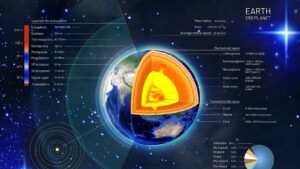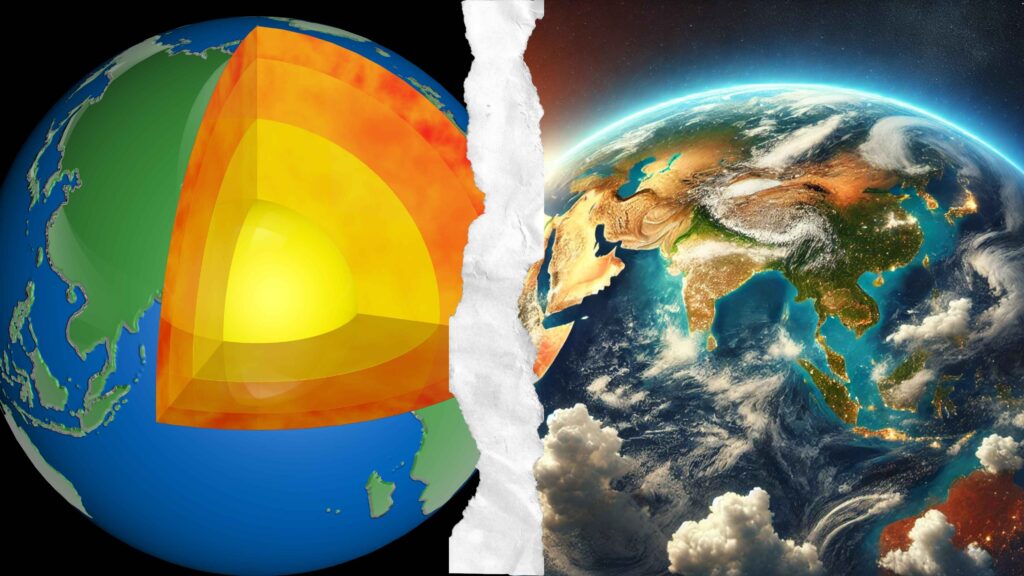Earth is our lovely home, which contains varied ecosystems, interesting geography, and a long history that determines life as we understand it. It is imperative for students and teachers to learn about the Earth’s structure, atmosphere, and environmental importance. Let us proceed on a mission to discover our planet in-depth.
The Structure of Earth
Earth consists of a number of different layers, each of which performs an important function in keeping the planet stable and providing life support functions.
1. Crust
▪️ The outermost surface, made up largely of rocks and minerals.
▪️ It comprises both continents and ocean bottoms.
▪️ The crust is the area that we inhabit, and it sustains mountains, forests, and other natural structures.
2. Mantle
▪️ Under the crust, the mantle consists of semi-solid rock.
▪️ The movement of this layer causes tectonic activity, resulting in earthquakes and volcanic eruptions.
3. Core
▪️ The core of the Earth consists of two parts: the outer core (liquid) and the inner core (solid).
▪️ The core produces Earth’s magnetic field, which shields life by deflecting dangerous solar radiation.
You may also like: “Cultivating Leadership in Young Minds for a Brighter Future.“

Earth’s Atmosphere
Our planet’s atmosphere is a protective blanket that maintains temperature and supports life.
Layers of the Atmosphere
▪️ Troposphere: The layer nearest the Earth’s surface, where weather is found.
▪️ Stratosphere: Has the ozone layer that protects Earth from lethal ultraviolet rays.
▪️ Mesosphere: Famous for incinerating meteors before they hit the surface of Earth.
▪️ Thermosphere: Where satellites orbit.
▪️ Exosphere: The external layer, blending with space.
Importance of Earth’s Ecosystems
The ecosystems of Earth maintain life. They yield food, oxygen, and habitat for millions of species. Some major ecosystems are:
1. Forests
▪️ Popularly referred to as “the lungs of the Earth,” forests store carbon dioxide and release oxygen.
▪️ Forests yield wood, medicinal plants, and food.
2. Oceans
▪️ Occupying 70% of the surface of Earth, oceans control climate and yield marine biodiversity.
▪️ Oceans contribute significantly towards the production of oxygen via phytoplankton.
3. Deserts
▪️ Though appearing dead, deserts harbor special species that live in extreme environments.
4. Grasslands
▪️ These open spaces feed herbivores and accommodate agriculture worldwide.
Climate and Weather

The climate of Earth is shaped by aspects such as ocean currents, pressure in the atmosphere, and human action. The study of climatic patterns enables us to forecast weather patterns and anticipate disasters.
Climate Zones
▪️ Tropical: Hot and wet areas close to the equator.
▪️ Temperate: Moderate climate with changing seasons.
▪️ Polar: Very cold areas close to the poles.
Earth’s Natural Resources
The earth provides rich natural resources that are used by humans to survive.
Renewable Resources
▪️ Solar, wind, and hydro power are renewable sources of energy critical for curbing pollution.
Non-Renewable Resources
▪️ Fossil fuels, minerals, and metals need to be consumed judiciously to avoid exhaustion.
Earth’s Role in the Solar System
Earth is the third planet in our solar system from the Sun and the sole planet that is known to harbor life. Reasons why Earth stands out include:
▪️ Existence of liquid water.
▪️ A covering environment that controls temperature.
▪️ Its optimal distance from the Sun provides moderate temperatures conducive to life.
Environmental Challenges
While Earth is naturally resilient, modern human activities threaten its stability.
Major Environmental Concerns
▪️ Deforestation: Leads to habitat loss and climate change.
▪️ Pollution: Air, water, and soil pollution impact ecosystems.
▪️ Global Warming: Rising temperatures affect ice caps, sea levels, and weather patterns.
The Role of Schools in Environmental Education
Schools such as Anee’s School have an important role in inculcating environmental consciousness in students. Schools enable children through interactive projects, science, and environmental clubs to become nature-sensitive citizens.
Initiatives for Students
▪️ Tree plantation drives to make places greener.
▪️ Recycling drives to conserve resources.
▪️ Environment-friendly campaigns making students resource-friendly.
Conclusion
Earth is a remarkable planet full of miracles that support life. Being inhabitants of this planet, we owe it to ourselves and future generations to take care of and conserve its ecosystems. Through improving our knowledge and embracing environmentally friendly practices, we can make Earth continue to be a lively and thriving home.
For the finest educational counseling and knowledge growth, pay a visit to Anee’s School in Kharar, Mohali, one of the finest CBSE schools around me that focuses on environmental consciousness and comprehensive education.
Read more important blogs from Anee’s School:








